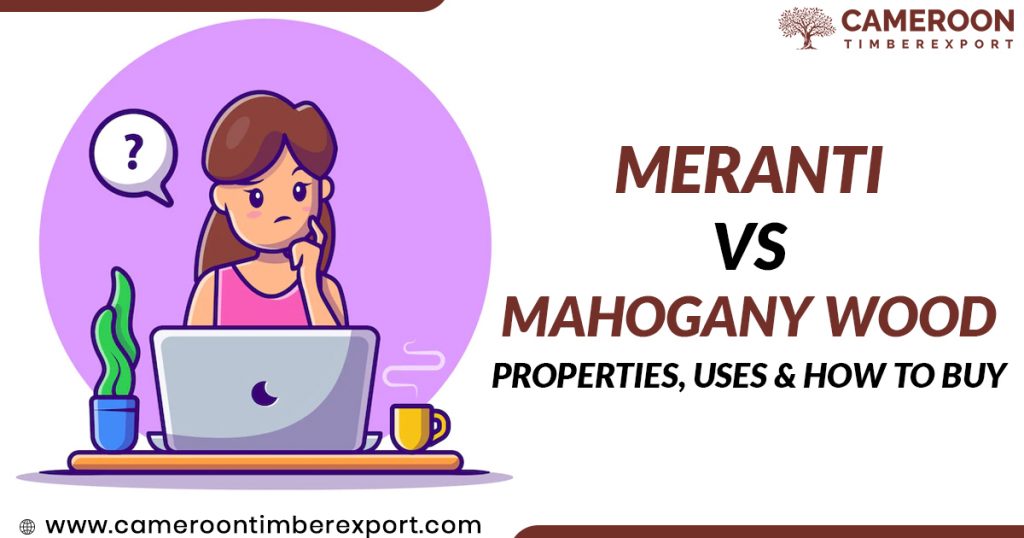Meranti and Mahogany are two very popular hardwood species. The two wood species share many similarities as well as many differences. In this article, we will talk about Mahogany and Meranti wood in detail, including their different properties, uses and the best place to buy high-quality hardwood timber.
Meranti Wood Overview
Meranti, sometimes called Philippine Mahogany for its resemblance to Mahogany, is a hardwood species found mainly in Southeast Asia. The trees are about 65-130 ft tall and have a 3-6 ft trunk diameter. Meranti wood is medium dense and almost non-durable. It has poor resistance to decay, rot and insect attack.
Meranti is mainly preferred for indoor applications, including general construction, plywood, flooring, etc. Because the natural wood lacks durability, it is often treated before outdoor use.
The five species of Meranti wood are: Light Red Meranti, White Meranti, Yellow Meranti, Dark Red Meranti, and Balau. All are found in Southeast Asia.
Meranti Wood Characteristics
Meranti is a dark reddish-brown wood and has white resin streaks present over its freshly sawn body. The grain is straight, sometimes interlocked, and the texture is coarse.
It is rated as non-durable to moderately durable and is medium hard and dense. It has poor resistance to rot, insects, moisture and decay.
Good looks aren’t the only reason why Meranti is liked all over the world. The wood is also fairly easy to work with and glues and stains well. It is easily available worldwide and is moderately priced for an imported wood. It holds nails and screws well, which is why it is prefered for plywood.
- Average Dried Weight: 42 lbs/ft3 (675 kg/m3)
- Specific Gravity (Basic, 12% MC): .55, .68
- Janka Hardness: 800 lbf (3,570 N)
- Modulus of Rupture: 12,710 lbf/in2 (87.7 MPa)
- Elastic Modulus: 1,743,000 lbf/in2 (12.02 GPa)
- Crushing Strength: 7,070 lbf/in2 (48.8 MPa)
- Shrinkage: Radial: 3.9%, Tangential: 7.8%, Volumetric: 12.5%, T/R Ratio: 2.0
About Mahogany Wood
We all have heard of Mahogany and most of us have personally used it. It’s one of the most popular hardwoods on the planet. Mahogany wood is known for its unmatched beauty, reddish-brown colour and outstanding strength. It is extensively used in a variety of applications all over the world.
Mahogany is famous for being very attractive. It comes in many species and grows in all parts of the world. Honduran Mahogany, also called genuine or brazilian mahogany, is the one we are talking about here. This species of mahogany is grown on plantations in Southern Mexico and central South America besides some other parts of the world. The trees are about 150-200 ft tall and have a 3-6 ft trunk diameter.
Mahogany Wood Characteristics
The heartwood is reddish-brown, however, the colour may range from pale brown to darker brown depending on the species and location. The colour of the wood darkens with age. The grain ranges from straight to wavy, interlocked or irregular. Mahogany has a medium uniform texture.
In terms of rot resistance, Mahogany is rated as very durable for a high-density wood grown in prime conditions. The older the wood, the darker, heavier, and more durable it is. However, it can be vulnerable to insect attacks, except for termites. Mahogany is a very stable wood, which makes it a perfect choice for fine quality furniture.
Mahogany is generally easy to work with. It sands, glues, finishes, and stains well.
- Average Dried Weight: 37 lbs/ft3 (590 kg/m3)
- Specific Gravity (Basic, 12% MC): 0.52, 0.59
- Janka Hardness: 900 lbf (4,020 N)
- Modulus of Rupture: 11,710 lbf/in2 (80.8 MPa)
- Elastic Modulus: 1,458,000 lbf/in2 (10.06 GPa)
- Crushing Strength: 6,760 lbf/in2 (46.6 MPa)
- Shrinkage: Radial: 2.9%, Tangential: 4.3%,
- Volumetric: 7.5%, T/R Ratio: 1.5
Honduran Mahogany has a high demand, though it is extensively available in lumber and veneer form. The price for an imported wood can be moderate to expensive.
Meranti vs Mahogany : Difference Table
| Feature | Meranti Wood | Mahogany Wood |
|---|---|---|
| Origin | Southeast Asia, primarily Malaysia | Native to Central and South America |
| Botanical Name | Shorea spp. | Swietenia spp. |
| Color | Light to dark reddish-brown | Reddish-brown to deep red |
| Grain | Straight to interlocked | Interlocked, sometimes wavy |
| Texture | Medium texture | Medium to coarse texture |
| Durability | Moderately durable | Highly durable, resistant to decay |
| Workability | Easy to work with moderate blunting | Relatively easy to work, may dull tools |
| Uses | Furniture, joinery, interior finishing | High-end furniture, cabinetry, boatbuilding |
| Sustainability | Varies by species and logging practices | Endangered in some regions, sustainability concerns |
| Cost | Generally less expensive | Can be expensive depending on quality |
Meranti and Mahogany share similar colour characteristics. Both have dark, reddish-brown colours. While the different species of Meranti have colours ranging from pale pink to dark brown, the most popular of these are dark coloured woods.
The major difference between mahogany and meranti (meranti vs mahogany) is durability. Whilst Mahogany is rated very durable and is resistant to termites, Meranti is almost non-durable and has poor resistance.
Meranti is majorly found in Southeast Asia, whilst Mahogany is almost exclusively grown in plantations in Latin America.
Both the demand and price of mahogany are higher than that of Meranti. Moreover, it is easier to trim and mould as compared to Mahogany.
Where to Buy Best Quality Meranti and Mahogany Wood?
Now that you understand all the major differences. You can buy top quality Meranti and Mahogany hardwoods from CameroonTimberExportSarl with doorstep delivery anywhere in the world. Yes, we are a leading exporter and supplier of hardwoods in the world. We ship to all major countries in Latin America, Asia, Europe, Australia, Canada, and other regions.
Contact us today for the best price for Meranti and Mahogany timber.

